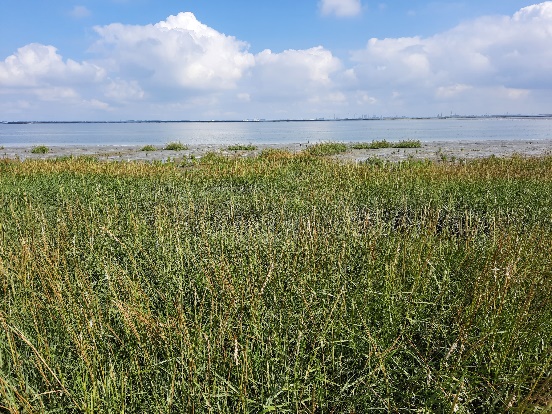M.M. Stoorvogel1,2*, J.C. de Smit3, J. van Belzen1, J. van de Koppel1,4, S. Temmerman5, P.M.J. Herman6,7, T.J. Bouma1,2
1 Royal Netherlands Insitute for Sea Research; 2 Utrecht University; 3 HZ University of Applied Sciences; 4 University of Groningen; 5 University of Antwerp; 6 Delft University of Technology; 7 Deltares
*corresponding author:
Introduction
Salt marshes have proven themselves as valuable for coastal protection, due to i) wave attenuation by the vegetated elevated marsh surface and due to ii) building such strong soils that they reduce the depth of a dike breach. To be able to create marshes with highly stable soils for flood safety (either in front of dikes, at managed realignment sites, or in transitional polders located between double dikes) requires a deeper understanding of the development of marsh soil stability under the influence of vegetation. We hence study soil stabilization of marsh soils with field studies and controlled experiments.
Methods
Field studies: We measured soil stability in pioneer salt marshes in the Westerschelde along age gradients to quantify the rate with which soil stability builds up over time. Spartina anglica was dominant in the pioneer zone at three salt marshes, while Scirpus maritimus was dominant at three brackish marshes. This enabled us to quantify the species-dependent effect on soil stability.
Controlled experiments: We set up a controlled experiment with pots filled with sandy or muddy sediment and which were left bare or were planted with Spartina anglica or Scirpus maritimus. All treatments (2 sediment types x 3 plant treatments) were subjected to four different tidal regimes. By studying the development of soil stability over time under different vegetation species, sediment type and tidal regime treatments, we quantified the effect of these variables on the build-up of soil stability.

Figure 1: A Spartina anglica pioneer salt marsh at Hoofdplaat in the Westerschelde
Results
Field studies: Our results show that Spartina anglica significantly increased soil strength compared to the bare mudflat within the first six years of vegetation coverage. Scirpus maritimus did not increase soil strength. We ascribe this difference to the different clonal expansion strategies of both species. Furthermore, we observed that soil stability typically decreased with longer inundation duration and higher soil water content.
Controlled experiments: In the controlled pot experiment, soil stability was higher in pots with vegetation than without vegetation, and higher in pots with sandy mud than with soft mud. Most build-up of soil stability over time resulted from the growth of the root systems.
Overall, we can conclude that vegetation, sediment properties and inundation duration are strongly affecting the build-up of soil stability in salt marshes. If we want to create salt marshes for coastal protection, we should consider these effects when assessing if a location is suitable to facilitate the formation of an erosion-resistant salt marsh soil that contributes to coastal protection, or if certain conditions need to be adjusted or managed or if a different location needs to be chosen.
I. Surname1*, F.N. Another-Surname2 , Y. Next-Surname2
1 University Name, Country; 2 Organization Name, Country
* Corresponding author: mail.name@organization.org


